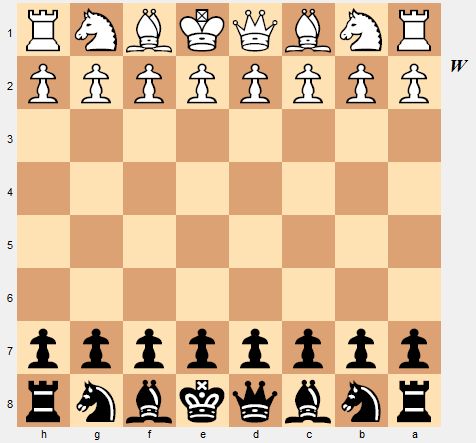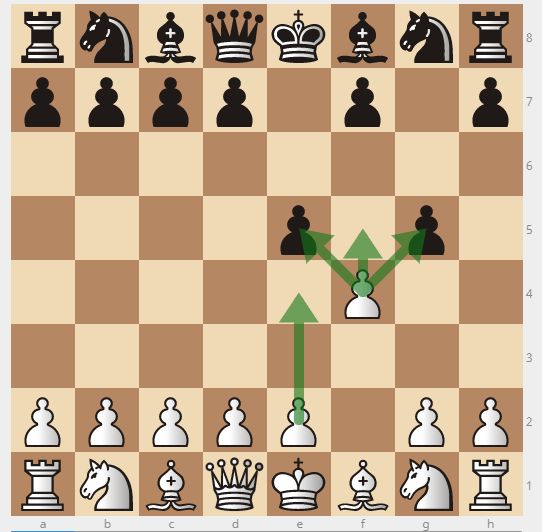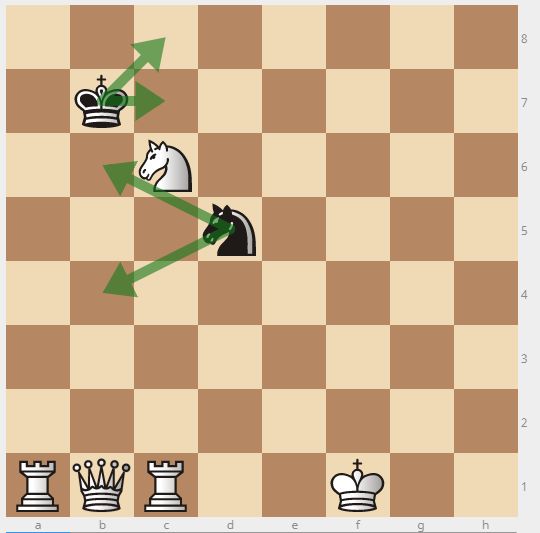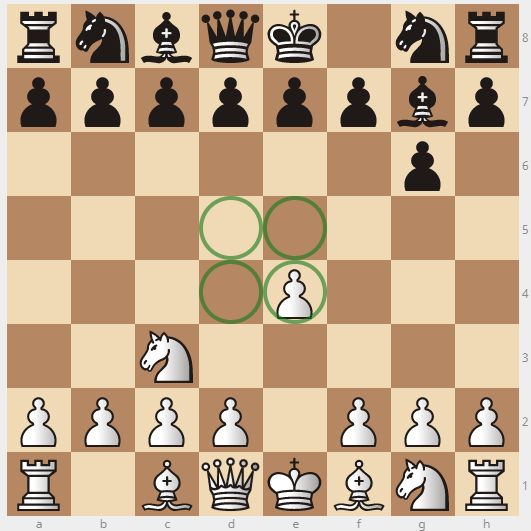|
Welcome, team black! The players are: Aces High anakha Flame Frionnel HardDiskD Ibblebibble Junpei Hyde LupusAter Mraagvpeine Odysseus S. Grant Snorb Talow Rules: The teams will choose their move based on a simple vote - Note that this means that explaining to your team mates why your suggested move is the best is just as important as coming up with it in the first place! Teams will have 24 hours to decide on their move, though I will call the vote early if one move gains a clear majority. (I will generally allow for longer voting times than I did in the previous game however) Please use long algebraic notation for your moves. I'd also prefer if as much team communication as possible is kept in the threads, both for the benefit of the observer thread and to make it easier for new players to follow the lines of thinking without having to use external sites. Lichess links are good though. Players aren't allowed to read the observer thread or the opposing team's thread, observers aren't allowed to post in the team threads. No use of chess engines to find moves is allowed, this includes playing either side of the position against the computer. To ensure that both teams have an equal playing field, the only allowed sources for openings etcetera are Wikipedia and chess.com. However, reading up on standard openings is encouraged as a good way to learn. Absolutely no super villainy allowed. Regarding mentors: The mentors who will be posting in the thread are idhrendur, oldskool and Dr. Fetus. Please add a  to the beginning of any posts in the team threads to separate you from players. to the beginning of any posts in the team threads to separate you from players.The mentors and myself will be available in the team threads to answer any questions and provide advice. To start off with, I will consider any questions that are not asking for specific move suggestions fair game. All post by mentors that are longer than simple "yes" or "no" answers should be crossposted to both threads. If mentors consider any questions a grey area, just check with me via pm or on Discord. Want more chess? If this thread doesn't provide enough chess in your life, I highly recommend you check out the free app Chess by Post! (Microsoft Store , Google Play, App Store) It features both ranked matchmade games against random players at the same skill level, and unranked games with friends with full compatibility across all devices. It also has a very handy move planner, which probably is the main thing saving me from constantly blundering. It also has an extremely merciful time limit for games, which is nice. Usernames of thread goons using the app (just let me know if you want to be added to this list!): covski idhrendur excloudygh circlmastr fatsamurai HisMajestyBOB Livewire42 Leylite Raldan CascadeBeta oath2order TheMightyMoltres schnibs herpicle alphakretin cxp moooo566 Covski fucked around with this message at 19:40 on Sep 20, 2017 |
|
|
|

|
| # ? May 3, 2024 15:49 |
|
Covski posted:Basics of chess: The pieces Covski posted:Algebraic notation Covski posted:Basic opening ideas: Covski fucked around with this message at 16:12 on Sep 11, 2017 |
|
|
|
 White has 24 hours to decide on a move.
|
|
|
|
oh boy BTW I assume the observer thread is off-limits now, but you might want to post a "DO NOT CROSS THIS LINE" in there now.
|
|
|
|
 Welcome to team black! I'll be checking in regularly if you have questions. Best of luck! Welcome to team black! I'll be checking in regularly if you have questions. Best of luck!
|
|
|
|
Gonna suggest e7-e5, it seems that starting off by moving a pawn is a generally solid opening move. If anyone has another sugestion then theyre free to present it.
|
|
|
|
Alright team black, we're clearly the best one, let's play this thing! Well let's see what white does first before we start planning right?
|
|
|
|
Hello fellow Team Blacks  I have the feeling they're going to open with their d/e pawn(forget which is the normal opening) so probably just mirror for the moment? Might as well keep our opening orthodox. I have the feeling they're going to open with their d/e pawn(forget which is the normal opening) so probably just mirror for the moment? Might as well keep our opening orthodox.Edit: mirror's the wrong word, the pawn on the other side of the centre 
|
|
|
|
Ibblebibble posted:Hello fellow Team Blacks e2-e4 is the 'standard' first move, I believe. Let's see what they do first and I'd generally suggest not doing anything drastic at least from the beginning. Let's all have fun 
|
|
|
|
Would "something drastic" be moving a knight in the first round?
|
|
|
|
Mraagvpeine posted:Would "something drastic" be moving a knight in the first round? As long as your motion is toward the center 4 squares of the board it's difficult to consider it drastic or weird.
|
|
|
|
I think we should wait to see what White does, and try to stick to more formalized openings. They are the standard for a reason, after all. On a more general note, this game might be low-level, but having an abundance of time and many people thinking about the move should prevent obvious mistakes, so we shouldn't try to force them. We start on the backfoot, and must play accordingly.
|
|
|
|
Coolguye posted:As long as your motion is toward the center 4 squares of the board it's difficult to consider it drastic or weird. quote:Players aren't allowed to read the observer thread or the opposing team's thread, observers aren't allowed to post in the team threads. 
|
|
|
|
Missed that, my mistake.
|
|
|
|
Hello teammates, looking forward to learning chess and making friends along the way. We're not the villains even though we are the colour commonly seen as what bad guys wear
|
|
|
|
 Hello everyone. I'll be happy to answer any basic chess questions you all have or to help people that are just getting lost. Remember to have fun, and behave well! It's just a game, after all. Hello everyone. I'll be happy to answer any basic chess questions you all have or to help people that are just getting lost. Remember to have fun, and behave well! It's just a game, after all.Also remember that Wikipedia is the only allowed source for info on opening moves.
|
|
|
|
Actually, after thinking about it a bit more I'll be amending the rules to allow chess.com as a source for information as well. Me changing the rules as I figure out what works is basically a trademark of mine by now anyway! Sorry about any confusion!
|
|
|
|
Hello friends, I doubt I'll have much to say besides voting, but I'll hope I can learn something from this.
|
|
|
|
Since we are waiting until White makes a move, how about we go into detail what are our chess experiences, if any? It's cool if you just post "I have been living under a rock for the past 2000 years and this is my first time I have even heard about this game.", but I think we should at least be acquainted between ourselves.  I'll start. My experience with chess is that of a child-level player, really.  Between the 4th and 8th grade I played in one intra-school tournament set up by the Phys. Ed. teachers and got second place, and played sporadically against some of the kids now and then. We were never very competitive, so the theory that I was exposed to then, never really went beyond how the pieces moved, and then we just went nuts playing the games "our" way. I think my very last game went down in flames because not everyone knew that en passant was a thing, and really never touched chess again. Also, I'm really poo poo at solving those chess puzzles, and that is to say that I can't do them at all. Between the 4th and 8th grade I played in one intra-school tournament set up by the Phys. Ed. teachers and got second place, and played sporadically against some of the kids now and then. We were never very competitive, so the theory that I was exposed to then, never really went beyond how the pieces moved, and then we just went nuts playing the games "our" way. I think my very last game went down in flames because not everyone knew that en passant was a thing, and really never touched chess again. Also, I'm really poo poo at solving those chess puzzles, and that is to say that I can't do them at all.
|
|
|
|
When I got my first cell phone it had chess on it so I played but I don't think I ever won a game. I can usually solve chess puzzles because it's usually just making one move but I've never been really good at seeing other moves from opponents so I would always get blindsided. I don't really understand how I am good/passable at piece-based board games yet seem to always fail whenever I play Chess. I think the only times I ever played chess regularly and won some was playing LEGO Chess on the computer but that was with the AI so low that it was making moves dumber than what Herp suggested  I think my biggest weakness when it comes to chess is that I don't really consider why I am moving pieces to certain places, the whole "think 5 moves ahead" stuff, and so if I see a move, like capturing a piece, I will just take it and not think about other things. Basically I'm not very good at seeing traps
|
|
|
|
I remember attending a chess class in a community center back when I was in elementary school. I was the youngest there and the lesson about castling stuck with me to this day. I played against the older people and lost most of the time. I also remember getting a chess game on CD-ROM and playing it on my dad's computer when he wasn't using it for work. I had moderate success at winning (though maybe a few of those wins involved using the command to go back moves Mraagvpeine fucked around with this message at 01:51 on Sep 12, 2017 |
|
|
|
Hello, good luck and hope to have fun.
|
|
|
|
I can beat the AI on easiest difficulty in Clubhouse Games. I have literally never won against a human playing chess.
|
|
|
|
Last chess game I won against a human was more than two decades ago. Last chess game I won against a computer was almost exactly 2 decades ago. Last full chess game I played against either a human or computer was in 1998.
|
|
|
|
I joined chess club for a couple of years in primary and lost terribly all the time because I kept going for pawns with no thinking beyond the next move.
|
|
|
|
I had a book on chess when I was a kid, and I had a chess board, so I've known the rules since then. I didn't have anyone to play with though, so all my knowledge (if any) is pretty much theoretical. Also, a few years ago I rewrote Deep Blue versus Garry Kasparov into a story, which sparked my interest again. No new experience since then, save for that game we've witnessed. Guess I'm bad at predicting opponent's moves and executing a good game plan, but I know the rules, and I'd like to try and analyze the game as we're playing. As for moving a knight in the first round. By something drastic, I meant unnecessary moves, early queen movements without reason, etc. Knights are fine. Though as I said before, as black our best chance would be responding to white's moves at first. There are many good openings, but we should at least stick to the one that counters whatever they try to do.
|
|
|
|
Since it's come up in both threads, a few thoughts about what is meant by book play. The fact of the matter is that chess openings are well researched enough that all the moves that are considered objectively better are mostly known. This does not mean that you should think of book openings as merely aping moves by expert players - rather think of them as a list of move suggestions to choose from, all with their own trade-offs and their own likelihood to result in different types of games. What they all have in common is that they are solid alternatives when picking a move (mostly - some really speculative plays have their own names and analyses) - you still need to make hard decisions on which book lines to pursue, which I'd personally argue is no less interesting as a learning exercise. It's also generally true that the player who decides to leave book ahead of time is the first player to deliberately make a sub-optimal move, usually losing something in the process. Of course this means that the opponent is out of book moves as well and it's not impossible to gain an advantage from this (especially if you are a stronger player but less well read on the opening), but the fact remains that you have given up something by choosing to leave the book in the first place. Remember: A move being a book move doesn't just mean it's well researched and known by your opponent, it also means that hundreds of years of chess play has shown it to be stronger than the alternatives. That said, do not take this as advice to stick to the book at all costs in this game: I just want to make the advantages of book play clear, and maybe change the way you think about it a bit. "Following standard book openings" sounds pretty boring, after all, but I promise it's not! Also, some terminology elaboration: A gambit is an opening in which one player offers a sacrifice (usually temporarily) a pawn to gain some kind of advantage. This can be a gain of tempo, an easier time developing your pieces, a positional advantage (often by having more pawns on the central squares), or a long term strategical advantage by weakening the opponent's pawn structure. Of course, the player who is offered the gambit has the choice to accept or decline the offered pawn. Oftentimes, a player accepting a gambit will not attempt to hold on to the extra pawn indefinitely, but will instead attempt to leverage their temporary material advantage for further gain. Pressure is to place any square or piece.The player defending the square/piece will have to commit more pieces to its defence, tying up resources and limiting their tactical flexibility. The player putting on the pressure retains the option of releasing the pressure by shifting attacking pieces to another place on the board, possibly to suddenly attack in another spot. Remember, me and the mentors are on hand if you have any questions about concepts or terms, or want any clarification on the strategic ideas of different openings or something along those lines.  I know this is a lot of information to take in at once, so don't be afraid to ask. Odds are that if you're wondering about something, other people are as well! I know this is a lot of information to take in at once, so don't be afraid to ask. Odds are that if you're wondering about something, other people are as well!
|
|
|
|
To amend my earlier point: Even when following book plays, I strongly encourage you to think long and hard and discuss why the moves are good. This is true generally, but especially for this game. Book play isn't a substitute for independent analysis but rather a good case study to try and figure out the reasoning why these moves are considered the best in that particular situation, and how that fits with your own understanding of the game.
|
|
|
|
 1. e2-e4 King's pawn game You have 24 hours to decide on a move. Covski fucked around with this message at 19:27 on Sep 12, 2017 |
|
|
|
Going to base most of this off the Wikipedia link Covski gave. Well the Scandinavian defense didn't really work out for the black team last time, but I think there's value in not going for the number one response in the Sicilian defense (c7-c5). I think we should go for the French defense (e7-e6). It gives a decent amount of options going forwards whilst maintaining a slight degree of unpredictability. Hopefully I'm not pulling a Herp with this suggestion. 
|
|
|
|
Looking at the wiki link Covski provided, I like the Sicilian Defence, c7-c5. It's a bold move, which has the potential to create a very complex game (and as such, lots of pitfalls for both us and them), but it's also the statistically best one. By committing to this we would sacrifice development (how many of our pieces can attack) in exchange for spatial advantage on the queenside (we'd threaten more spaces on the right side of the board), while still contesting control of the center. Let's be hot-blooded, let's go Sicilian.
|
|
|
|
I like the idea of the French defense, but that apparently usually traps our white-square bishop. I'd say to stick to the popular move and play the Sicilian defense (c7-c5).
Space Kablooey fucked around with this message at 04:11 on Sep 13, 2017 |
|
|
|
e: changed to c7-c5 Odysseus S. Grant fucked around with this message at 08:13 on Sep 13, 2017 |
|
|
|
Yeah, I think I like e7-e6 for opening up the queen and black-bishop.
|
|
|
|
I don't recall ever having consciously played anything other than E7-E5 in my games with other human players. The myriad of options Black has in response to E4 has me Still, as Covski said, the most popular response is most popular for a valid reason. I'll go with C7-C5.
|
|
|
|
I like the options that have been posted here, but i think i'll throw my support for C7-C5 for now, i like the options that one gives us.
|
|
|
|
I was going to suggest moving the knight out, I think that would be Nf6? but I suppose we aren't really equipped for something like that so I will go along with C7 to C5 as well. I just want to pieces other than pawns darn it 
|
|
|
|
c7-c5 is the most common defense to this, isn't it? Why not go with that? (Besides, of course, the most common response to King's Pawn Opening would have shitloads of responses...) Anyway, fun fact: Each of the twenty opening moves White can start with has a unique name, according to chess.com.
|
|
|
|
Despite being the most popular and successful, I think Sicilian is a bold move. My first thought would be to just respond with e7-e5 and proceed to an open game. I'm not sure we can reap the benefits of this opening in the long run and yes, pulling a herp would be awful. However, I'm still voting for c7-c5 We would need to attack from the queen side, I guess? I'm thinking about moving that knight so that we could contest some center squares (our c-pawn doesn't contribute a lot from my point of view).
|
|
|
|

|
| # ? May 3, 2024 15:49 |
|
I think the idea of the C pawn coming out first is to take their D pawn if they decide to go dx-d4? Or at least that's what I gleaned from the article.
|
|
|




































